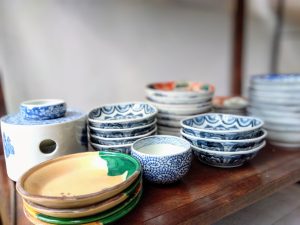今も昔も旅は良いものですが(愛知県名古屋市千種区姫池通 骨董買取 古美術風光舎)
2025.05.17
梅雨の気配を感じるようなお天気となりました。九州南部では梅雨入りだそうで…。東海地方は6月のはじめ頃のようですが、じめじめのあの季節がもうすぐそこだと思うと少し憂鬱になります。

お天気は悪くとも、万博は気になりますし、先日からのスタッフブログにもありました国宝展も気になるところです。おでかけしたいななどと考えておりましたら、昨日は1689年に俳人・松尾芭蕉が江戸を出て東北に旅立った日にあたるそうで、「旅の日」なる日だったようです。
芭蕉が歩いたとされる奥の細道は、江戸の深川から岐阜の大垣までの距離約600里(約2,400km)。距離に関しては諸説ありますが、東北経由の150日間にも及ぶ歩き旅は、現代人の感覚からすると、とんでもない距離に思えます。
芭蕉は江戸を出てから5カ月かけて太平洋側を北上して東北・北陸を巡り、日本海側を南下して岐阜県の大垣まで旅をし、途中、多くの美しい景色に出会い、たくさんの名句を読み、「おくのほそ道」を後世に残すことになるわけですが、江戸時代の旅は今ほど気軽なものではなかったに違いありません。当時は当たり前に関所がありますので、通過するために通行手形が必要。時には通行手形がなくて厳しく問いつめられたなんてこともあったようです。
私は小心者故に、行き当たりばったりの旅よりは、やっぱりある程度の下準備を含め計画は必要かなと思う派ですが、芭蕉の「おくのほそ道」の旅にも、今で言う敏腕コーディネーターのような同行者がおりまして、訪問先にあらかじめ書簡を送り、芭蕉が行きたい場所、会いたい人、食べたいものなどを知らせ、手配を完璧にこなしていたそうです。
その方、河合曾良(かわいそら)は当初の予定を変更して抜擢されたそうですが、俳句の腕前はさておき、神道や地理、全国の神社仏閣に詳しく、性格も几帳面。一緒に旅するのに最適の人物だったようです。彼のおかげで、旅はスムーズそのもの。彼なくして「奥の細道」は生まれなかったかもしれません。
江戸時代には自動車も電車もありませんので、基本歩け歩けがあたり前。東海道を旅する人たちは、1日に30~40kmくらいの距離は歩いていたそうです。今とは違い、江戸時代、普段の暮らしで履かれていたのは下駄や草履。ですが、鼻緒に足指を引っかけただけで遠出の旅には向いていません。そこで長い ”緒” を足首に巻き付け、しっかり固定できる草鞋(わらじ)が必須アイテムでした。
時代劇の役者さんは素足に草鞋(わらじ)を履くため、撮影の間中鼻緒擦れには悩まされるそうですが、昔の人なら履き慣れているから平気かと思うとそうでもないようで、粗悪なわらじを無理して履き続けると「わらじ食い」、今でいう鼻緒擦れで、昔の人も悩まされていたようです。
『東海道中膝栗毛』にも、
「履きつけぬわらじで足中が豆だらけだ、わらじの紐が食い込んだ」
と嘆く場面があります。「わらじ食い」を起こさぬための工夫もなされて、わらじ紐に布を巻いたりして防いでいたようです。
そんな足元条件の悪い中で30~40kmも歩くなんて、真似できそうにもない気もしますが、江戸末期からまだ170年しか経っていなと考えると、私の身体にも、1日30~40kmくらいを歩けるだけのポテンシャルが眠っているということになるのだろうか…。まあ、あったとしても…ですね。
ではでは、また。(スタッフT)

The weather is now showing signs of the rainy season. I heard that the rainy season has begun in southern Kyushu. It seems to be around the beginning of June in the Tokai region, and it makes me a little depressed to think that the dreary season is almost here.
Even if the weather is bad, I am still interested in the Expo and the National Treasure Exhibition as mentioned in the staff blog from the other day. As I was thinking about these things, it seems that yesterday was “Traveling Day,” the day in 1689 when haiku poet Matsuo Basho left Edo (Tokyo) for Tohoku (northeastern Japan).
The Okunohosomichi, or Narrow Road to the Deep North, which Basho is said to have walked, is about 600 ri (about 2,400 km) from Fukagawa in Edo to Ogaki in Gifu. There are various theories about the distance, but the 150 days of walking via Tohoku seems an extraordinary distance from the perspective of modern people.
Basho spent five months after leaving Edo (Tokyo), traveling northward along the Pacific Ocean side to Tohoku and Hokuriku, then southward along the Sea of Japan side to Ogaki in Gifu Prefecture, encountering many beautiful landscapes along the way, reading many famous poems, and leaving “Okunohosomichi” for posterity. Traveling in the Edo period must not have been as easy as it is now. In those days, it was commonplace to have a barrier, so a passport was required to pass through. Sometimes, people were even questioned severely because they did not have a passport.
Basho’s “Okunohosomichi” trip also had a companion who was like a skilled coordinator. Basho sent letters to the places he wanted to visit, the people he wanted to meet, the food he wanted to eat, etc., and he made all the arrangements perfectly.
That person, Kawai Sora, was selected after a change of plans, and aside from his haiku skills, he was well versed in Shintoism, geography, shrines and temples throughout Japan, and had a meticulous personality. He seemed to be the perfect person to travel with. Thanks to him, the trip went smoothly. Without him, “Okunohosomichi” might not have been born.
In the Edo period, there were no automobiles or trains, so the basic rule was to walk and walk and walk. People traveling on the Tokaido Highway walked a distance of about 30 to 40 km a day. Unlike today, geta or zori were worn in everyday life during the Edo period. However, they were not suitable for long journeys, as they were just hooked onto the noseband with the toes. Therefore, sandals (waraji) with a long “oo” wrapped around the ankle and securely fastened were a must-have item.
Actors in period dramas wore straw sandals on their bare feet, so they suffered from nose strap chafing during filming.
In “Tokaido Chu Hizakurige” (The Tokaido Chu Hizakurige), it is written,
In “Tokaido Chu Hizakurige,” there is a scene in which a man laments, “My feet are covered with beans from wearing straw sandals that I never put on.
The laces of the straw sandals have eaten into my feet. It seems that they had devised a way to prevent “waraji bite” by wrapping a cloth around the straps of the straw sandals.
I don’t think I could imitate walking 30 to 40 km in such poor footing conditions, but considering that only 170 years have passed since the end of the Edo period, I wonder if my body has enough potential to walk 30 to 40 km a day. No, no, of course it is impossible. No, no, of course not.
See you later. (Staff T)
*****************
ご実家の整理やお片付けなどをされている方のご相談などが多くございます。
お片付けなどくれぐれもご無理のないようになさってくださいませ。
風光舎では古美術品や骨董品の他にも絵画や宝石、趣味のお品など様々なジャンルのものを買受しております。
お片付けをされていて、こういうものでもいいのかしらと迷われているものでも、どうぞお気軽にご相談下さいませ。
また風光舎は、出張買取も強化しております。ご近所はもちろん、愛知県内、岐阜県、三重県その他の県へも出張いたします。
まずは、お電話お待ちしております。
なお、毎月21日の持込鑑定会では無料鑑定・買取・持込など、ご予約なしで承っております。
ご近所の皆さま、ご遠方のみなさまも、お気軽にお越しくださいませ。
愛知県名古屋市千種区姫池通
骨董 買取【古美術 風光舎 名古屋店】
TEL052(734)8444
10:00-18:00 OPEN
#出張買取#骨董#古美術#骨董品#絵画#版画#茶道具#刀剣#彫刻

